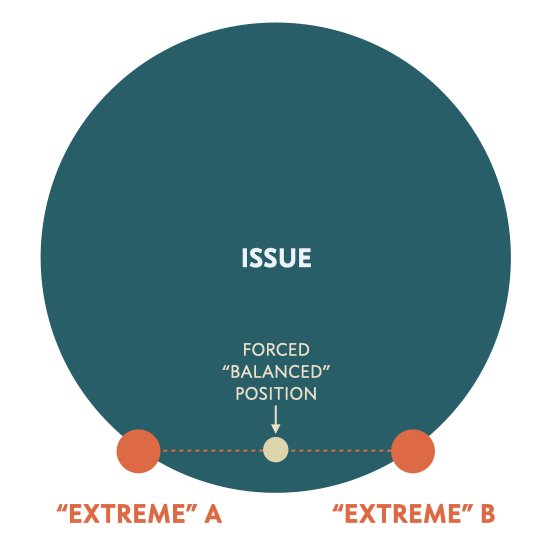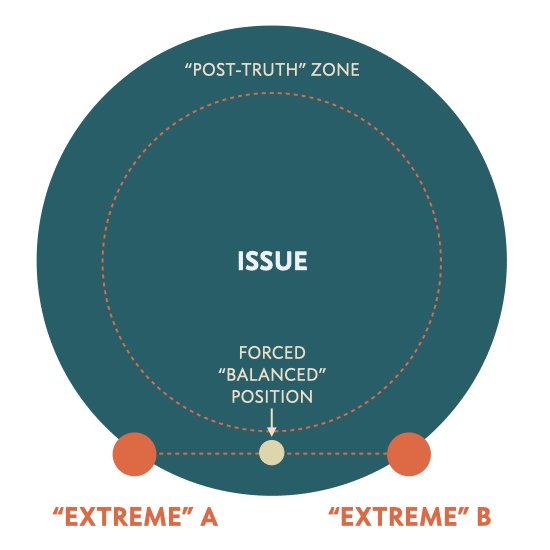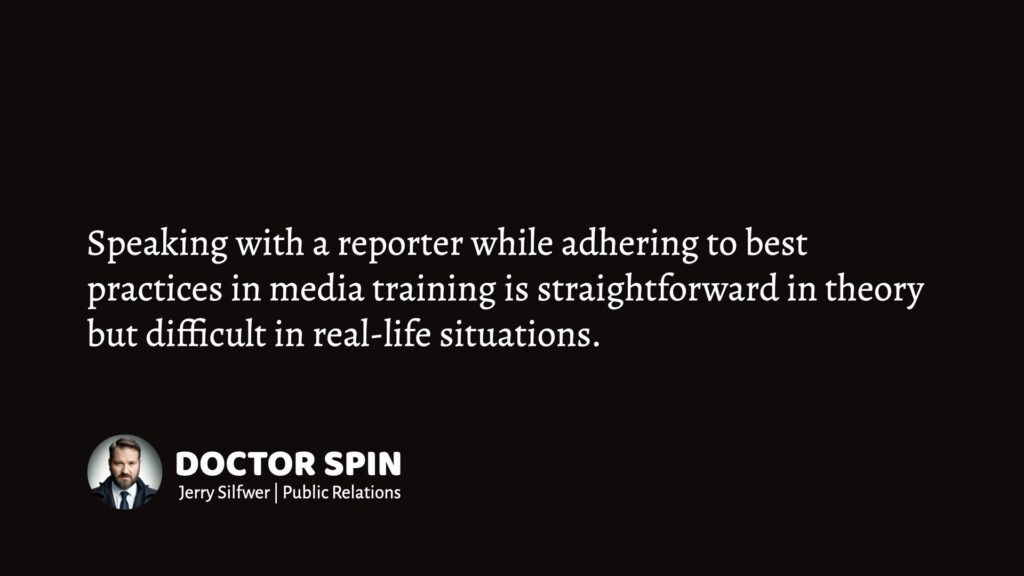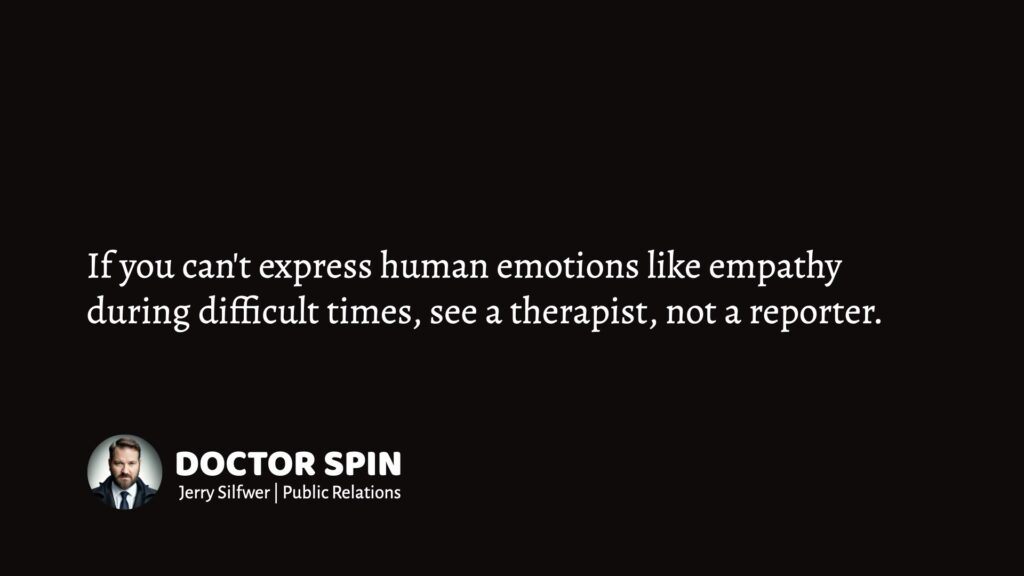Let’s discuss the media blackout and its effects.
What compels organisations to decline media interview requests, and what implications does this have for the future of investigative journalism?
Moreover, how do these tactics reflect the changing nature of trust, transparency, and truth for journalism in the long term?
Here we go:
The Media Blackout Tactic
Spin Academy | Online PR Courses
The Media Blackout Tactic
More and more organisations are deliberately avoiding any interaction with legacy news media:
Media Blackout = when an organisation intentionally avoid engaging with legacy news media, often to control the narrative and protect interests. Journalists criticise this practice as it obstructs investigative reporting and undermines information transparency.
Media Blackouts are the result of unfair rules of engagement in a “Post-Truth” media landscape:
Media Minefield = the “Post-Truth” media landscape where interactions with legacy news media often result in deliberate misrepresentation. Organisations navigate this terrain cautiously to avoid damaging their reputation and public image.
The Media Analysis
To resolve the situation, we face two main challenges:
However, as a PR professional with 18+ years of experience, I believe we will fall short on both these challenges.
Legacy news media will continue to fall apart — where the erosion of trust from organisations will be one of many contributing factors. Organisations will likely opt for “Post-Truth” strategies, leading to organisational corrosion from the inside out.
“Post-truth is a societal phenomenon, influenced by the expectation that honesty is the default position, and the public tolerance of inaccurate and undefended allegations in politics.”
Source: Nature 1Higgins, K. (2016). Post-truth: a guide for the perplexed. Nature, 540, 9 – 9. https://doi.org/10.1038/540009a
Instead, new “societal pillars” must be born out of the rubble: a new form of independent news media based on trust (not clicks or ideology) and a new form of successful organisations based on transparency (not avoidance or exploitation).
Learn more: The Media Blackout: When PR Declines Media Interviews
💡 Subscribe and get a free ebook on how to get better PR ideas.

The Polarisation of News Media
Spin Academy | Online PR Courses
The Media Polarisation Model
We often hear how the media climate is “polarised” — a known and reasonably well-understood effect of classic media logic.
It also seems true that social media logic has amplified the effects of polarisation by grouping people into echo chambers where confirmation bias, conversion theory, and the hostile media effect are allowed to roam freely without any checks and balances.
“Political elites, partisan media, and social media contribute to societal-level political polarization, leading to misperceptions of division among the electorate and fueling animosity and actual ideological polarization over time.”
Source: Current Opinion in Behavioral Sciences 2Wilson, A., Parker, V., & Feinberg, M. (2020). Polarization in the contemporary political and media landscape. Current Opinion in Behavioral Sciences, 34, 223 – 228. … Continue reading
More deeply, media polarisation is problematic because it draws false lines between extremes that aren’t necessarily perpendicular. These “false lines” will force otherwise balanced media consumers to place themselves between the media-suggested extremes.

At the extremes, sheltered by the social safety of a like-minded peer group (i.e. echo chamber), it’s possible to disregard opposing evidence as “attacks” on their position. As the amplification hypothesis states, any such attacks will only strengthen the position of the extremes.
Through media polarisation, the amplification hypothesis sustains a “Post-Truth” Zone at the extremes. If a) the zone is wide enough and b) the extremes are sufficiently close to each other, the forced “balanced” position between them will end up in the “Post-Truth” Zone as well.
“Post-truth is a societal phenomenon, influenced by the expectation that honesty is the default position, and the public tolerance of inaccurate and undefended allegations in politics.”
Source: Nature 3Higgins, K. (2016). Post-truth: a guide for the perplexed. Nature, 540, 9 – 9. https://doi.org/10.1038/540009a

The forced “balanced” position is weak and arguably also extreme, therefore crediting (not threatening) all extreme post-truth positions.
Since the forced “balanced” position will have a hard time sheltering anyone from our fear of social isolation, the spiral of silence partially explains why extremes are so effective in silencing the majority of otherwise balanced media consumers. 4Silfwer, J. (2020, June 4). The Spiral of Silence. Doctor Spin | The PR Blog. https://doctorspin.net/spiral-of-silence/
Learn more: The Media Polarisation Model
💡 Subscribe and get a free ebook on how to get better PR ideas.


Thanks for reading. Please support my blog by sharing articles with other communications and marketing professionals. You might also consider my PR services or speaking engagements.
PR Resource: Media Training Advice

Spin Academy | Online PR Courses
Classic Media Training Advice
Speaking with a reporter while adhering to best practices in media training is straightforward in theory but difficult in real-life situations.
Here is some classic media training advice:
Learn more: Classic Media Training Advice
💡 Subscribe and get a free ebook on how to get better PR ideas.

PR Resource: Media Training Mistakes

Spin Academy | Online PR Courses
Classic Media Training Mistakes
Standing before a camera or a microphone can be stressful, especially during a crisis. Therefore, many leaders, politicians, and communication professionals invest in professional media training.
However, media training can be taken too far.
Answers Without Substance
Exaggerating the Bridge Technique
Parrotting Your Key Message
Staring Down the Reporter
Relying on Non-Apologies
Using Platitudes and Jargon
Transposing Human Emotions
Learn more: Classic Media Training Mistakes
💡 Subscribe and get a free ebook on how to get better PR ideas.

ANNOTATIONS
| 1, 3 | Higgins, K. (2016). Post-truth: a guide for the perplexed. Nature, 540, 9 – 9. https://doi.org/10.1038/540009a |
|---|---|
| 2 | Wilson, A., Parker, V., & Feinberg, M. (2020). Polarization in the contemporary political and media landscape. Current Opinion in Behavioral Sciences, 34, 223 – 228. https://doi.org/10.31234/osf.io/yqvzc |
| 4 | Silfwer, J. (2020, June 4). The Spiral of Silence. Doctor Spin | The PR Blog. https://doctorspin.net/spiral-of-silence/ |
| 5 | Silfwer, J. (2024, May 2). The Core Message. Doctor Spin | The PR Blog. https://doctorspin.net/core-message/ |
| 6, 11 | Silfwer, J. (2015, October 9). The Platitude Sickness: The Trash of Corporate Writing. Doctor Spin | The PR Blog. https://doctorspin.net/platitude-sickness/ |
| 7, 10 | Silfwer, J. (2020, July 26). When a Public Apology is Warranted (And When It’s Not). Doctor Spin | The PR Blog. https://doctorspin.net/public-apology/ |
| 8, 9 | Silfwer, J. (2020, May 23). Corporate Cringe. Doctor Spin | The PR Blog. https://doctorspin.net/corporate-cringe/ |























